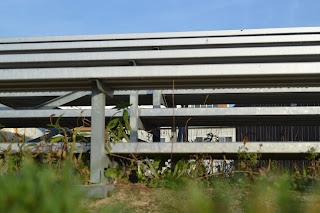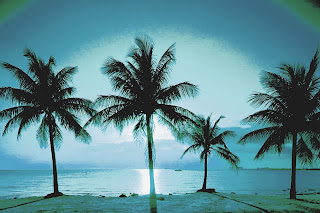Gregory Crewdson, Untitled (Birth), 2007
INITIAL REACTION
When I first saw this piece, I got an uneasy, cold feeling from the tone and content of this photo. This photo made me feel uncomfortable but at the same time, I could not look away, trying to analyze what was going on. Seeing this work reminded me of long car rides to Florida during winter vacation because my family would always stay in motels similar to the one shown. This movement suggests that a woman had just given birth (either at that moment or recently, based on the size of the baby) in a motel room. This work evokes feelings of loneliness and regret from the expression shown on her face. She almost looks disappointed and lost in a thought. What puzzles me is why she is in a motel room and why the main door is opened.
ANALYSIS AND INTERPRETATION
This work uses:
· Texture – the dirty, rough snow.
· Line – horizontal lines on the motel and vertical lines of the bars.
· Tone – different shades of colour due to the shadows and lights in the motel.
I think that the theme/subject of this work is regret. By the look on the woman’s face, you can tell that she looks at the child as if it is an inanimate object, almost disappointed or disgusted (in herself?). Since the work is titled “Birth”, I am assuming the woman in the photo ran off from her family or hometown to give birth in an isolated motel. The birthing of the child is evident since the child does indeed look like a newborn child and is not wearing any clothes. It also seems like it was a rushed procedure since the main door is left wide-open. It is hard to tell what the age of the woman is. If she is a teenager, it is possible that Crewdson wanted to portray teen pregnancy after-effects however; it is more likely that the woman is an adult since she is able to freely rent a motel room all by herself (not the norm for teenaged girls). But since she is most likely an adult, judging by the disappointing or disgusted look on her face and the absence of a male figure, Crewdson may be portraying the after-effects of a rape victim – ashamed, therefore, has the need to run off the give birth. As she looks at the child, it seems as though she does not know what to do with the child because it could be the result of such a horrid experience. I feel as though Crewdson’s view of the world based on this photo is very accurate. In certain cases such as this, it would be a hard decision what to do with the child as shown on the expression on the woman’s face and overall cold surroundings.
CONSIDERATION OF CULTURAL CONTEXT
Many sources of media may have influenced Crewdson in this work. There are many stories of rape as well as newborn children being abandoned or killed. It all seems horrible but many people do not know how the mother feels. Having a child to remind her of such experiences will scar her for life, making the decision to get rid of the child difficult. This photo shows sympathy for many victims. Perhaps Crewdson knows a story better from events in his life. Perhaps he has a friend or family member who has gone through such experiences, but maybe not to the extent of having a child or even killing it. It is expected that the audience feels uneasy about this photo because it is definitely not portrayed as happy. Having a woman alone in a motel room looking uncomfortably at her newborn child is not something one would find as a happy photo.
EXPRESSION OF AESTHETIC JUDGEMENT
The choice of dark, cold colours really adds to the eeriness and mystery of the photo. The dark colours can symbolize a dark past. The look on the woman’s face is definitely a key component. If she were looking away, it would be harder to analyze the photo. From my initial reaction, I had thought that the woman had simply regretted having sexual intercourse resulting in a child but after analyzing the photo further, it is evident to me that she could possible be a rape victim. Crewdson definitely evokes sadness, regret, and loneliness by using dark colours, model expressions and cold settings (winter night at a motel).














































